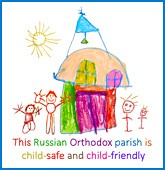This page was updated on 4 February 2025 and remains a work in progress. In time we plan to add hyperlinks to other material on this website (done 22/2/2025), a brief introduction to vestments in the Orthodox Church, photographs of each item mentioned, and a list of references (done 12/2/2025).
The sticharion is a long-sleeved, enclosed ankle-length robe worn by all ranks of clergy when participating in the divine services. It has its origin in the everyday clothing of men and women in the ancient world, and in the Byzantine-era requirement that the clergy always put on a clean robe when serving. Altar-servers, readers, subdeacons, and deacons wear a wide-sleeved sticharion in the appointed liturgical colour; priests wear a narrow-sleeved white sticharion that usually has a decorative fringe. In all cases there is a cross on the back, positioned between the shoulder blades. When putting on the sticharion the deacon or priest says a vesting prayer based on verses of Isaiah 61: “My soul shall rejoice in the Lord, for He hath clothed me in the garment of salvation, and with the vesture of gladness has He covered me; He hath placed a crown upon me as on a bridegroom, and He hath adorned me as a bride with comeliness.”
The orarion is a long rectangular garment, generally about 15 centimetres wide and 250-300 centimetres long, worn over the left shoulder by deacons. It is decorated with crosses and other Christian symbols, trimmed with galloon, and has a fringe at the ends. It has its origins in the Roman pallium, a rectangular cloak worn in formal settings by teachers and those in positions of authority. During the Byzantine era it became the practice for civil servants – and ultimately, the Christian clergy – to wear a stylised form of the pallium as a ceremonial “scarf of office”. Accordingly, the orarion is worn whenever the deacon is exercising his liturgical office. The deacon holds the front portion of the orarion in his right hand when intoning the litanies. Subdeacons and some altar-servers wear the orarion crossed over both shoulders and wrapped around the waist.
The double orarion is a longer form of the orarion, generally about 450 centimetres long. It too is worn over the left shoulder, with the greater length wrapped across the deacon's chest and back, passing under the right arm. In the Russian tradition the right to wear the double orarion is given to deacons as the first liturgical award. In the Russian Orthodox Church Outside Russia (ROCOR), this award is generally given to a deacon only after three years of service. Reflecting the higher rank of the deacon wearing it, the double orarion is usually far more ornate than the simple orarion. The double orarion worn by a protodeacon customarily has the words “Holy, Holy, Holy” («Свят, свят, свят») embroidered on it. These words call to mind Isaiah’s vision of the service of the higher angels at the throne of the Lord (Isaiah 6:1-13).
The epitrachelion is for priests, like the orarion for deacons, a ceremonial “scarf of office”, and so is worn whenever the priest is exercising any priestly function. It is placed around the neck with two sides of equal length extending down to the ankles. The two sides are sewn together or joined by buttons down the middle. Like the orarion, the epitrachelion is decorated with crosses and other Christian symbols and trimmed with galloon. It has a fringe at the bottom with many threads that symbolise the souls that the priest has in his care. When putting on the epitrachelion the priest says a vesting prayer based on verses of Psalm 132: “Blessed is God Who poureth out His grace upon His priests, like unto the oil of myrrh upon the head, which runneth down upon the beard, upon the bread of Aaron, which runneth down to the fringe of his raiment.”
The belt is a practical item worn by the priest that holds the sticharion and epitrachelion in place. It has a small cross at the centre front and ribbons to tie it around the waist. When putting on the belt the priest says a vesting prayer based on verses of Psalm 17: “Blessed is God Who girded me with power, and hath made my path blameless, Who maketh my feet like the feet of a hart, and setteth me upon high places.” This prayer reminds the priest that it is God Who gives him strength for his ministry.
The cuffs are small rectangular vestments decorated with a cross and fastened around the wrists with a cord that is interlaced through metal rings attached to each end of the rectangle. Cuffs are worn by both the deacon and the priest. For the priest, they serve the practical purpose of containing the sleeves of the sticharion. When putting on the right cuff the deacon or priest says a vesting prayer based on verses of the Song of Moses in Exodus 15: “Thy right hand, O Lord, is glorified in strength; Thy right hand, O Lord, hath shattered enemies, and in the multitude of Thy glory hast Thou ground down the adversaries.” When putting on the left cuff the deacon or priest says a vesting prayer based on verses of Psalm 118: “Thy hands have made me and fashioned me; give me understanding and I will learn Thy commandments.” As with the prayer for the belt, these prayers remind the deacon or priest that it is God Who gives him strength for his ministry.
The phelonion is a vestment, longer at the back and shorter in front, that is worn by the priest over his other vestments during Divine Liturgy and the most solemn parts of the other divine services. It has its origin in the paenula, a protective semi-circular cloak worn by men and women in the ancient world. It generally has a cross or an icon on the back. In the Russian tradition, the phelonion has a high back that extends above the neckline. When putting on the phelonion the priest says a vesting prayer based on verses of Psalm 131: “Thy priests, O Lord, shall be clothed with righteousness, and Thy saints with rejoicing shall rejoice, always, now and ever, and unto the ages of ages. Amen.” A special shortened form of the phelonion is used at the tonsure of a reader, that rank being "the first degree of the priesthood."
The nabedrennik is a rectangular vestment, suspended from the corners on the upper short side by a long ribbon and worn by priests, initially over the right thigh. It has its origin in the thigh-shields worn beneath a sword as a mark of distinction by high-ranking warriors in ancient times. The nabedrennik has a cross in the middle. In the Russian tradition, the right to wear the nabedrennik is the first liturgical award for a priest; in ROCOR, it is generally only granted after three years of service. When putting on the nabedrennik the priest says a vesting prayer based on verses of Psalm 44: “Gird Thy sword upon Thy thigh, O Mighty One, in Thy comeliness and Thy Beauty, and bend Thy bow, and proceed prosperously, and be king, because of truth and meekness and righteousness, and Thy right hand shall guide Thee wondrously, always, now and ever, and unto the ages of ages. Amen.” The sword called to mind is “the sword of the Spirit, which is the word of God” (Ephesians 6:17). When the right to wear the palitsa is granted, the nabedrennik is instead worn over the left thigh and is put on with a simple prayer: "Let us pray to the Lord! Lord have mercy."
In the Russian tradition, the skufiya is a soft brimless cap constructed of four panels. It may be made of a lightweight fabric such as cotton or linen or, more commonly, a heavier fabric such as velvet. A black skufiya may be worn by monastics and by deacons, priests, and bishops when a head covering is required in a non-liturgical setting. A purple skufiya, awarded to married priests as a mark of distinction, is worn in non-liturgical settings, and will also be worn during the divine services until the right to wear the kamilavka is granted. In the ROCOR the right to wear the purple skufiya is the second liturgical award for a priest; it is generally only granted after six years of service.
In the Russian tradition, the kamilavka is a stiff cylindrical hat, covered in velvet and expanding outwardly towards the top. A black kamilavka is worn by monastic deacons during the divine services. A purple kamilavka, awarded to married deacons and priests as a mark of distinction, is worn in formal non-liturgical settings and during the divine services. Kamilavkas in red, blue and green are also sometimes worn. In the tradition of the ROCOR, the right to wear the kamilavka is the third and highest liturgical award for a deacon, generally granted only after fifteen years of service. For a priest it is the third liturgical award, generally granted only after nine years of service.
The pectoral cross is a large cross suspended on a chain and worn by priests on the chest. In the Russian tradition, all priests wear a pectoral cross in non-liturgical settings and during the divine services; in some other Orthodox traditions, the right to wear a pectoral cross is always an award. Priests in the Russian tradition are presented with a silver pectoral cross upon ordination. The right to wear the gold pectoral cross or the jewelled pectoral cross is granted as an award. The gold pectoral cross is the fourth liturgical award for a priest; in the ROCOR it is generally only granted after 12 years of service. The jewelled pectoral cross is the seventh liturgical award for a priest; it is generally only granted after 21 years of service. On rare occasions a senior priest will be granted the right to wear two jewelled pectoral crosses; in the ROCOR this generally only occurs after more than 40 years of service.
The palitsa is a diamond-shaped vestment, suspended from one corner by a long ribbon and worn by priests over the right thigh. Like the nabedrennik, it has its origin in the thigh-shields worn beneath a sword as a mark of distinction by high-ranking warriors in ancient times. The palitsa generally has a cross in the middle but may also be embroidered with an icon. In the Russian tradition, the right to wear the palitsa is the sixth liturgical award for a priest; in the ROCOR it is generally only granted after 18 years of service. When vesting with it the priest says the same prayer as for vesting with the nabedrennik: “Gird Thy sword upon Thy thigh, O Mighty One, in Thy comeliness and Thy Beauty, and bend Thy bow, and proceed prosperously, and be king, because of truth and meekness and righteousness, and Thy right hand shall guide Thee wondrously, always, now and ever, and unto the ages of ages. Amen.”
McGuckin, John Anthony. The Encyclopedia of Eastern Orthodox Christianity. Wiley-Blackwell, 2011.
Norris, Herbert. Church Vestments: Their Origin and Development. Mineola, NY: Dover Publications, 2002.
Parry, Ken, David J. Melling, Dimitri Brady, Sidney H. Griffith, and John F. Healey. The Blackwell Dictionary of Eastern Christianity. Oxford: Blackwell Publishers, 2002.
Patte, Daniel. The Cambridge Dictionary of Christianity. Cambridge University Press, 2010.
Service Book: The Divine Liturgy of Saint John Chrysostom. Jordanville, NY: Holy Trinity Monastery, 1999.
Sokolof, Archpriest D. A Manual of the Orthodox Church’s Divine Services. Jordanville, NY: Printshop of St. Job of Pochaev, 2001.
West, Krista M. The Garments of Salvation: Orthodox Christian Liturgical Vesture. Yonkers, NY: St Vladimir’s Seminary Press, 2013.

























